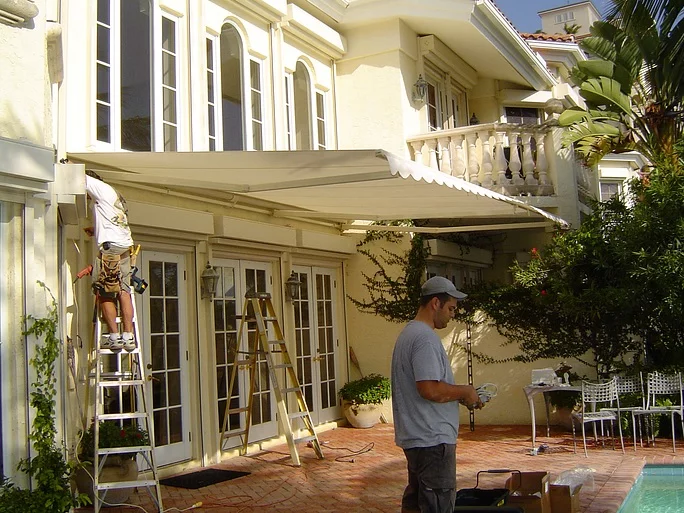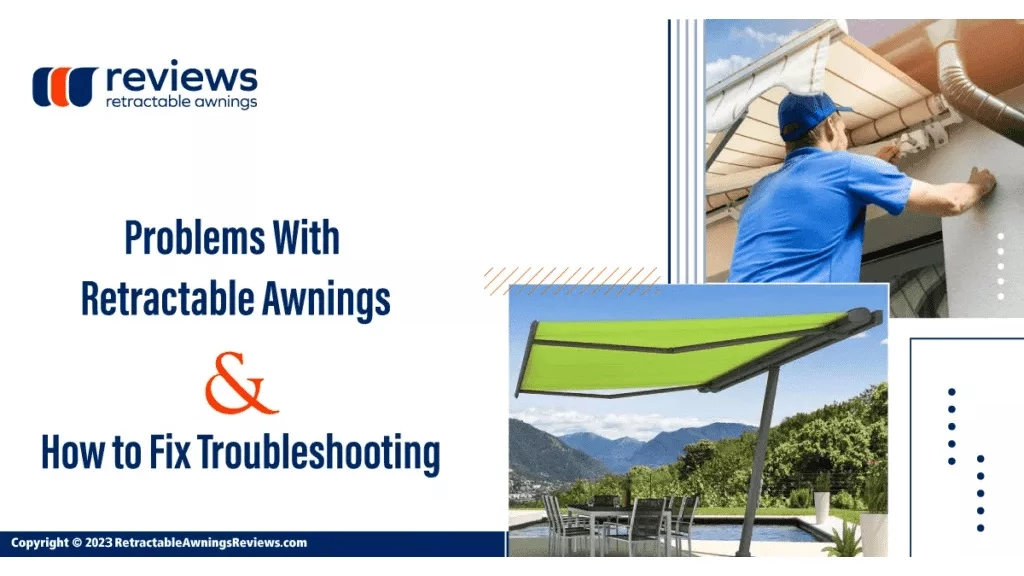Retractable awnings provide great protection from elements like the sun and light rain. With regular use, retractable awning problems can begin to arise. If you encounter any issues with retractable awnings, this blog on awning troubleshooting can help.
The Most Common Problems with Manual and Retractable Awnings
Fixing a manual or retractable awning can sometimes feel overwhelming. But, as you’ll see, the solutions are usually quite simple. You can solve most awning problems with a good amount of preventative measures and simple common-sense solutions. Here are common awning troubles and some easy repairs for them.
Table of Contents
- Knocking or Cracking
- The Fabric of the Awning Sags
- An Electric Awning Won’t Retract
- Fungus or Mold
- Wind Issues
- Damage From the Sun
- Damage From Snow
- Damage From Rain
- Bees and Other Insects
- Squirrels, Rats, Possums, and Bird Nesting
- Conclusion
Knocking or Cracking
Many common manual retractable awning problems involve hearing knocking or cracking noises. Many awning owners fear this is a sign of a significant awning malfunction.
These sounds are usually a result of your awning brackets not being tight enough. Make sure you securely seat the torsion or square bar in your awning’s mounting brackets. Then, tighten the mounting bolt to draw the locking lip entirely over the bar.
The Fabric of the Awning Sags
An overextended awning can cause its fabric to begin sagging or loosening. The solution for this manual or retractable awning problem is to reverse the direction of cranking until your awning’s fabric is tight.
In addition to reverse cranking, it’s important to take note of how the fabric is rolling. Keep your awning’s fabric taught by ensuring it rolls over the top of the roller tube instead of underneath it.
An Electric Awning Won’t Retract

A motorized awning is convenient. But it also has parts that can fail. If your motorized awning stopped functioning, there’s a pretty simple fix.
Most motors of automated or electric awnings contain a built-in thermal override. This override prevents awning motors from overheating during excessive use. If your automated electric awning stops working, wait 10 to 15 minutes to let the motor cool. Now, the awning should work properly again. If your electric awning still isn’t retracting, check the batteries in your awning’s remote control or wireless wall switch. You’ll also want to check your electrical circuit breaker panel.
Fungus or Mold
The insidious growth of mold could be a notable problem for manual and retractable awning fabrics. Awnings are often exposed to a combination of water, humidity, and heat, creating fertile ground for mold growth.
At the first sign of mold growth, completely spray your awning with a hose. Next, apply a mildew remover taking into account the fabric manufacturer’s mold removal and cleaning recommendations. Then, allow the awning to dry completely before retracting or closing it.
Wind Issues
It is essential to retract your awnings in strong winds. That’s because the best retractable awnings are not designed to withstand anything more than a fresh breeze – Beaufort #5 (+-19-24 mph).
You should always retract your awnings when you’re not home to prevent damage from a sudden storm or gust of wind. A great addition to any electric awning that won’t retract on its own is an automated anemometer wind sensor or a motion sensor. These products will retract awnings when the wind gets too strong.
Damage From the Sun

Sun damage to an awning is almost inevitable. Sun damage can cause the fabric of your awning to fade over time. Keeping your awnings clean can slow this process.
Solve this manual or retractable awning problem by sweeping your awnings to remove debris and dust. Then, apply mild soap to your awnings and use a hose to finish the cleaning process. Do not use a pressure washer, as it will make holes and/or rip your awning’s fabric, thus voiding the fabric warranty. It is also advisable to review the fabric manufacturer’s cleaning recommendations and instructions prior to starting the cleaning process.
Damage From Snow
The accumulation of snow on your motorized awning can cause severe damage, such as tearing its fabric, bending its frame, arms, and damaging its moving parts. At the first sign of snowfall, remove any accumulated snow promptly. Once that is done, retract the awning to protect it from further damage from snow accumulation.
Damage From Rain
Retractable awnings offer protection from the sun and light rain. However, problems can happen when your awning doesn’t repel water properly. This situation can cause water to begin pooling on an awning’s fabric.
This manual or retractable awning problem usually happens when there isn’t enough pitch or angle on a retractable electric awning’s arms and fabric. If you notice water beginning to pool, remove the water immediately and then pitch your retractable awning down further to prevent pooling.
Bees and Other Insects
The cozy corners of your roof and an extended awning make an excellent place for a beehive. The problem is that hives can damage parts of your awning, not to mention the other dangers hives might pose to you. The best solution to this situation is to keep the awning retracted when not in use.
Another helpful tip is to avoid leaving food, drinks, and trash on your patio or yard. These are things insects feed upon. If these preventative measures don’t stop bees from building a hive, call a professional to deal with an established beehive.
Squirrels, Rats, Opossums, and Bird Nesting
Bees aren’t the only animals that cause problems with manual or retractable awnings. Many critters might think your awning is a cozy place to live. All sorts of animals love to nest in your awning to stay protected from the elements.
The easiest solution for this is to keep your awning closed when it’s not in use. If you begin to see any rodent or bird nesting, safely remove it. If you feel uncomfortable doing that, call a professional promptly to remove the nest. Purchasing a fully enclosed full cassette model will prevent nesting birds and fabric-chewing rodents from inhabiting your awning.
As you can see, there are several manual or retractable awning problems. But, in all cases, the solutions are usually pretty simple. The table below lists common awning issues and their solutions.
| Manual and Retractable Awning Problems | Solutions |
| Knocking or cracking | Tighten the brackets that hold the awning in place. |
| Fabric sags | Reverse crank the awning until taught and make sure the fabric rolls correctly over the roller tube. |
| Electric awning won’t retract | Wait 10 to 15 minutes for the automated motor to cool down. |
| Fungus or mold | Clean with a broom or vacuum. Then, hose the awning and apply a mild mildew remover. |
| Wind | Keep your awning retracted when not in use. Also, add a wind or motion sensor to automatically close your awning in strong winds. |
| Sun | Keep your awning clean by sweeping it. Then, use a mild soap and water to clean it. |
| Snow | Remove any accumulated snow and retract the awning. |
| Rain | Pitch down or retract the awning to keep water from pooling on its fabric. |
| Bees | Limit food sources for the bees. Keep the awning retracted when not in use. |
| Nesting | Remove nesting promptly and keep the awning retracted when not in use. Or install a fully enclosed, full cassette awning. |
Where You Can Go For More Help
If you’re a current awning owner or considering an awning, but are unsure of what’s right for you, RetractableAwningsReviews.com has the information you need. You can look at this website’s product reviews to help walk you through the pros and cons of various awning and pergola products. You’ll also find thorough walkthroughs of common manual and retractable awning problems owners face and recommended solutions for these issues.
